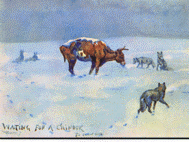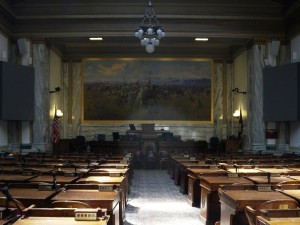» posted on Friday, August 10th, 2012 by Linda Lou Burton
Talent Is
 Linda Burton posting from Helena, Montana – “To have talent is no credit to its owner,” Charlie Russell said in 1925. “What man can’t help he should get neither credit nor blame for.” Charles Marion Russell (1864-1926) moved to Montana when he was sixteen, seeking the life of a cowboy. It wasn’t his talent, however; he was fired from his sheep-ranching job in just a few months. He followed Jake Hoover for a while, hunting and trapping; then hired on as a wrangler at a cattle ranch near Missoula. He was finally living the cowboy life, going on cattle drives; he continued this for seven years. He also spent a year with the Blackfoot Indians, learning their ceremonies, hunting methods, and tribal legends. He sketched and drew these things he experienced during a time of Montana’s vanishing frontier – the 1880’s and 1890’s. And Charlie Russell found his talent. He created more than 4,000 paintings, drawings, and sculptures in his lifetime, becoming one of the world’s best-known and most authentic western artists. Today his statue represents Montana in Statuary Hall in Washington, DC. As I read the story of this remarkable man, I see two significant marking points – in 1886 and in 1896 – when the talent he was so modest about began to be recognized.
Linda Burton posting from Helena, Montana – “To have talent is no credit to its owner,” Charlie Russell said in 1925. “What man can’t help he should get neither credit nor blame for.” Charles Marion Russell (1864-1926) moved to Montana when he was sixteen, seeking the life of a cowboy. It wasn’t his talent, however; he was fired from his sheep-ranching job in just a few months. He followed Jake Hoover for a while, hunting and trapping; then hired on as a wrangler at a cattle ranch near Missoula. He was finally living the cowboy life, going on cattle drives; he continued this for seven years. He also spent a year with the Blackfoot Indians, learning their ceremonies, hunting methods, and tribal legends. He sketched and drew these things he experienced during a time of Montana’s vanishing frontier – the 1880’s and 1890’s. And Charlie Russell found his talent. He created more than 4,000 paintings, drawings, and sculptures in his lifetime, becoming one of the world’s best-known and most authentic western artists. Today his statue represents Montana in Statuary Hall in Washington, DC. As I read the story of this remarkable man, I see two significant marking points – in 1886 and in 1896 – when the talent he was so modest about began to be recognized.
 Charlie Russell’s artistic leanings came forth even though he didn’t take himself seriously as an artist at first; he gave away most of the things he created. Then came the winter of 1886, a brutal one for the cattle business. Russell worked at the OH Ranch near Missoula at the time; when the owner sent a letter asking how the cattle were faring, he did a small watercolor of a starving cow standing in the snow, circled by wolves. The manager of the ranch¸ seeing this, threw away the letter he was writing to the owner and instead sent only this small postcard painting. It didn’t make any money for Russell, but it made a name for him outside Montana, and made him more seriously consider a career as an artist.
Charlie Russell’s artistic leanings came forth even though he didn’t take himself seriously as an artist at first; he gave away most of the things he created. Then came the winter of 1886, a brutal one for the cattle business. Russell worked at the OH Ranch near Missoula at the time; when the owner sent a letter asking how the cattle were faring, he did a small watercolor of a starving cow standing in the snow, circled by wolves. The manager of the ranch¸ seeing this, threw away the letter he was writing to the owner and instead sent only this small postcard painting. It didn’t make any money for Russell, but it made a name for him outside Montana, and made him more seriously consider a career as an artist.
 That winter also changed cattle ranching forever in Montana. Farmers began moving into the area; the railroads brought even more people in; fences closed off the open frontier. The decimation of the buffalo ended the Indians traditional way of life. Charlie Russell moved to Great Falls, Montana in 1893, spending much of his time along the Rocky Mountain Front where he painted, created models, and met new people. One of them was Nancy Cooper (1878-1940); they married in 1896; he was 32, she was 18. Though much younger than her husband, Nancy shrewdly managed their finances and helped to promote his paintings.
That winter also changed cattle ranching forever in Montana. Farmers began moving into the area; the railroads brought even more people in; fences closed off the open frontier. The decimation of the buffalo ended the Indians traditional way of life. Charlie Russell moved to Great Falls, Montana in 1893, spending much of his time along the Rocky Mountain Front where he painted, created models, and met new people. One of them was Nancy Cooper (1878-1940); they married in 1896; he was 32, she was 18. Though much younger than her husband, Nancy shrewdly managed their finances and helped to promote his paintings.
In 1911 his work was shown at the Folsom Galleries in New York; the show was titled “The West That Has Passed.” After an impressive review in the New York Times, the prices for his artwork went up significantly; by 1920 his paintings sold for $10,000. He said at the time “”My wife has been an inspiration to me in my work. Without her I would probably never have attempted to soar or reach any height, further than to make a few pictures for my friends and old acquaintances.”
 He died in 1926, but in his lifetime produced detailed and sensitive paintings portraying the west “the way it was.” His desire to portray the Indians accurately set him apart from other artists of this period who often showed them as savages. He also had a great interest in the Lewis and Clark Expedition and produced many paintings and sculptures about their journey. His largest painting Lewis and Clark Meeting the Flatheads in Ross’ Hole September 4, 1805 hangs in the House of Representatives in the Montana State Capitol; it was created in 1912 and measures 25 x 12 feet.
He died in 1926, but in his lifetime produced detailed and sensitive paintings portraying the west “the way it was.” His desire to portray the Indians accurately set him apart from other artists of this period who often showed them as savages. He also had a great interest in the Lewis and Clark Expedition and produced many paintings and sculptures about their journey. His largest painting Lewis and Clark Meeting the Flatheads in Ross’ Hole September 4, 1805 hangs in the House of Representatives in the Montana State Capitol; it was created in 1912 and measures 25 x 12 feet.
In 2011, his 1892 painting Water for Camp, showing Native American women dipping pots into a stream, and his 1924 watercolor A Dangerous Sport, in which two cowboys lasso a mountain lion, sold for nearly $1.5 million each.
See over 200 pieces of Russell art in the Montana Historical Society, Helena, Montana; one of the most significant collections anywhere with 24 major oils, 60 bronzes, and 34 illustrated letters. http://mhs.mt.gov/museum/default.asp
Visit the C M Russell Museum, and his home and studio, in Great Falls, Montana. http://cmrussell.org/
